Research Division
Reprinted from "INSULATORS - Crown Jewels of the Wire", June 1971, page 23
It is difficult for me to describe the insulator sketched below. The bottom
part is of a non-metallic material, asbestos perhaps? The threads are also of
this material. Front, on the ear, WESTINGHOUSE; Back, 47744B.
Winferd Henry
Mitchell, Indiana
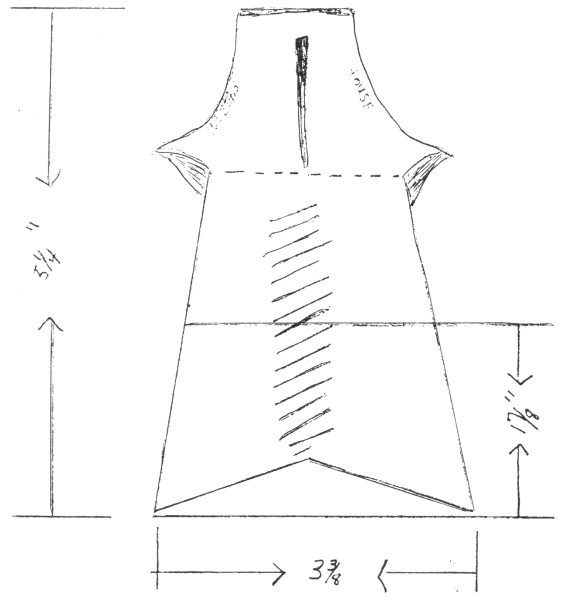
I'm writing in reply to Joanne Kelsey inquiry in the April 1971 "Crown
Jewels" about the pony insulator. I'm a lineman for United Telephone Co. of
Ind., and in the past six months have found eight of these units in northeastern
Ind. They are of a K. C. G. W. mold that has been altered to a no name. Some
I've found are very clear, while others are dim, and one couldn't be seen at
all. The embossing is just below one dot, and appears as a series of faint dots in this form:

Also, the big dots have "tears" running
down from them, and the color is lt. aqua.
I've found another no name K. C. G. W. in CD 121 toll. These are a well made,
heavy unit in a pretty ice blue. The characteristic dots appear at rt. angles to
the mold line. Absolutely no embossing was legible an the five I found, all in
one exchange. I've seen only one other, which may have been found in N. W. Ohio.
See Milholland's Book No. 2, page 34, for more information on the K. S. G. W.
dots.
We enjoy the "Crown Jewels" very much. I would like to see more
articles on the history of various styled units.
Sincerely,
David Ramp
Enjoy your Magazine immensely. Keep up the good work. Would anyone have any
info on a Transposition I have? It is the top of a two piecer, blue-aqua, swirl
start threads, mold line to just above standard sized groove. It is embossed TWO
PIECE TRANSPOSITION, with the word "transposition" under "two
piece". Letters are 1/4" high. It stands 3" tall. Base is
3-10/16" wide. No inner skirt:. threads 1" up from base. Who has this
or knows of it? Any info will be gratefully accepted. Thank you.
Dana Paul
Whitney
P. S. Anyone have a base?
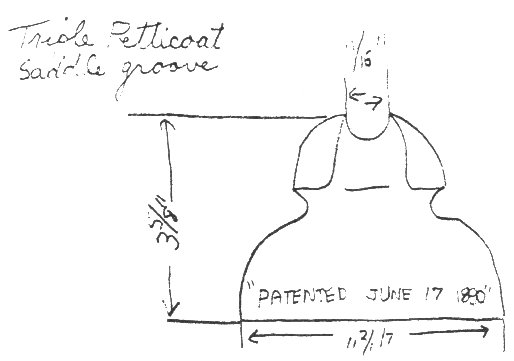
Robert Eiland (Crown Jewels, April '71) may have stumbled onto a real lead,
as I have also found insulators with that same patent date, in quotations, as
pictured. I found them in an old, power shed, where they were evidently used to support lines to the outside, in association with similar insulators
of Knowles manufacture, which were embossed with a raised emerald-cut prism on
the skirt. These insulators are described in Milholland's Reference Book No. 2 as CD 292 and in Cranfill
and Kareofelas Volume II as the Knowles "Lachine" insulator. Could there thus be a connection between the mysterious star glass works and
the Knowles outfit? Could the star glass works, responsible for many bottles dug
in various locations, be the same as that responsible for such a widespread group of insulators?
Interesting questions. These insulators are described in Milholland's Reference Book No. 2 as CD 292 and in Cranfill
and Kareofelas Volume II as the Knowles "Lachine" insulator. Could there thus be a connection between the mysterious star glass works and
the Knowles outfit? Could the star glass works, responsible for many bottles dug
in various locations, be the same as that responsible for such a widespread group of insulators?
Interesting questions.
Sincerely,
Rick Ollich
P. S. The shed where these were found is just south of Lenox, in the town of
Glendale, Mass.
Editors note: According to Mr. Woodward's book, The Glass Insulator in
America, the patent date of June 17, 1890 was issued to Samuel Oakman concerning
Saddle groove. Both insulators mentioned are saddle grooves.

I am a new subscriber of Crown Jewels . . . and enjoy reading the articles on
insulators located and stories by collectors on different companies. So I
thought I would enter a sketch of a threadless that I dug up on the New York
Central near Michigan City.
The unit is in half: the other half, I couldn't find. It stands 5-1/2"
high and 4" in diameter at the base. It is of opaque aqua glass with mold
lines that stop at the flat dome. The dome has a raised plateau, I guess for hammering on the pin. It is said
to be a "Leefers", but I do not see any marks on the section I own. If anyone has any information,
please
forward it to me.
Thank you,
Paul E. Mohrs
Box 186 -A Rt. 2
Michigan City, Ind. 46360
I have a real puzzler for your research department. The enclosed drawing is
of an insulator which was found by a friend of mine who is a bottle nut. He dug
this, and several others just like it, out of an old dump which has been closed
for about eighty years. I said my friend was a bottle nut, and I think you'll
agree, for when he digs, he really digs. He came upon these insulators after
digging down ten feet.
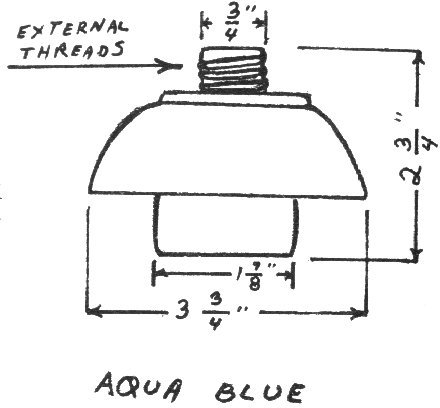
If you can identify this for me, I would greatly appreciate it. Also, I want
to find out the approximate value, for I have some to trade. One reliable source
from Middletown, N. Y. thinks it may be a McKee, made in Pittsburg, for a patent
(#107075) was issued to Sam McKee on September 6, 1870 for a screw thread on the
exterior of an insulator to screw into the bottom of a cross arm.
Thank you very much.
Robert D. Cossaboom
15 Springhill Ave.
Bridgewater,
Mass. 02324
I was very much interested in the letter, sent in by Bob May, which described
iridizing Pyrex insulators. When I was doing research for my article on
TRANSMISSION LINE INSULATORS which was published in the Old Bottle Magazine
(Vol. 3, Nos. 2, 3 & 4, starting in the March 1970 issue) I tried, without
much success, to get information about this process and about the methods of
coloring Carnival Glass dishes. I am still trying to learn how Carnival Glass
was, or is, colored, and I would be very thankful to any one who would send me
references to information on these methods. Or can any one tell me POSITIVELY
that the English Iridescent Glass, described by C. C. Manly in the Spinning
Wheel for Jan. & Feb. 1969 (Vol. 25, No. 1) is the same as Carnival Glass?
Sincerely,
C. H. Turner
722 E. Normal St.
Springfield, Mo. 65804
I have another odd-ball. It is an egg or strain insulator that is made of
cast iron. Ever hear of such a thing? It measures 2-5/16" x 3-1/16". I
know of one other one in a collection.
I may have some information on the insulator pictured on page 24 of the April
1971 Crown Jewels. I just traded for one that measures exactly the same in all
respects. Under one of the dots is the number 5. Under the other are the blocked
out letters KCGW.
I also have the following CD 160 baby signals that were not in the January
1971 issue of Crown Jewels:
#1 F. Hemingray B-N. (Solid raised dot) 14, SDP Aqua
#2 H. G. Co. /Patent May 21, 1893, B - Petticoat, SDP, Clear
#3 F-Hemingray-14/Patent May 2, 1893, B - Made in U.S.A. / Petticoat, 1893, SDP, a
more Blue
#4 F-Hemingray-14/Petticoat, B - Made in U.S.A. /Patent May 2, 1893, SDP, a
more Blue
#5 F-H. G. Co., B - Petticoat, NDP, Light Aqua
#6 F-Brookfield, B - New York, NDP, Yellow Green (I call this yellow green,
although it may be olive green.)
Also have the B SDP Aqua that was listed in a later issue of Crown Jewels.
Guess that's all for now. Hope these will be of interest. Keep up the good
work.
Sincerely,
George F. Lahm
P. S. All drawings were done as near to exact dimensions as possible, but
have been reduced 25% to fit the pages of Crown Jewels.
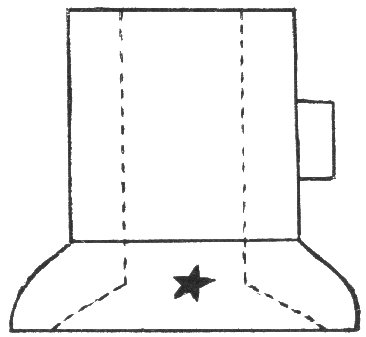
I think this insulator is scarce, as I know of only one other. It measures
2-5/16" at base and is 2-3/16" high. It is embossed with one 5 point
star. Color, lt. aqua.
This is a mottled brown porcelain insulator. I have two other tops that are
yellow. The pat. date is for a 1 piece trans. Insulator looks like it was sawed
in half. It is threaded.
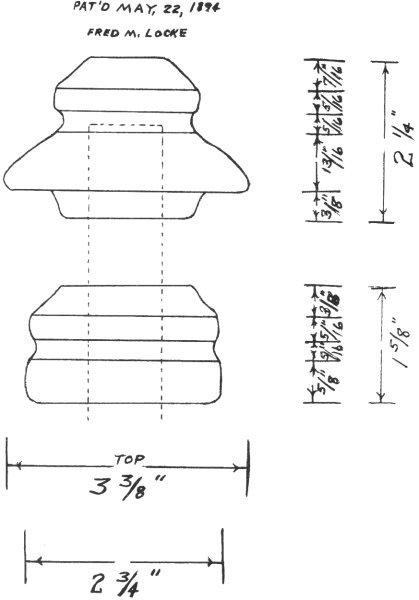
This is a lt. aqua threaded insulator. The more solid lines in the center of
the insulator may have been from a previous mold that was segmented. It measures
2-1/2" x 3-5/8".
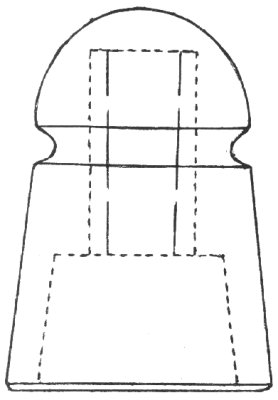 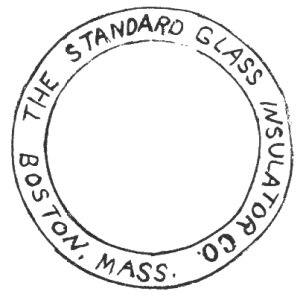
I believe this is a CD 161 Hawley. It measures 3-1/8" wide x 4"
high. It is threaded, Color is aqua.
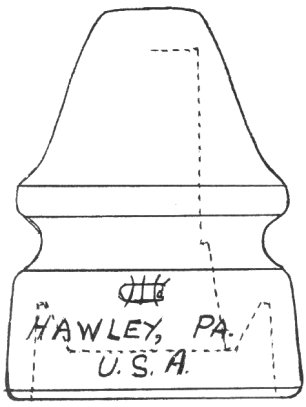
| 